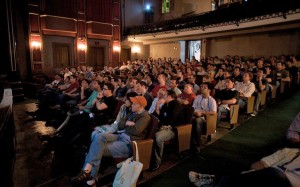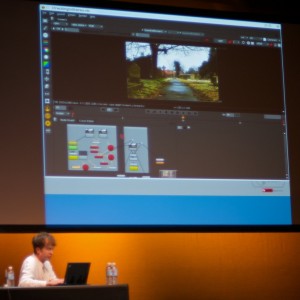Day one: Siggraph got off to a good start in a city that is both extremely hot and welcoming. The trade show floor does not open until Tuesday, so the first day was all about the talks, with some brilliant presentations. Day One also saw a flood of press releases and the odd user group meeting.
Day 1:
 Papers and Talks:
Papers and Talks:
The Talks started early on day one, for me the stand out paper of the day was Pixar’s Patrick Lin – more about that in a sec…
The technical papers start as does the trade show on Day 2 of the conference but the day was full of Siggraph Talks.. it can be a bit confusing for anyone who has not watched the Siggraph conference evolve but there are:
Technical papers : Hard core algorithmic tech presentations – with the most rigorous vetting of any event
Talks: These are not presenting new research but discussing new work
Courses: Often times key landmark past papers and growth areas are presented as a more complete overview survey.
Panels: A discussion panel around a topic.
Production Sessions: these are talks but arranged by a different sub committee ! (seriously)
Vendor Talks These are not Siggraph talks in the main program but talks often on the booths – but often just as popular
And the list goes on, (we are not making this up).. Birds of a feather, games papers, art papers, etc.
To be really confusing the Animation festival that runs as part of Siggraph has extended to include its own talks – Production Sessions, …confused? Well half the attendees were on day one. Literally hundreds of people filed into the technical talks expecting the Digital Domain Animation Festival talk on Building Benjamin Button. Which led to the most comic round of several hundred people playing musical chairs at 8.30 on a Monday morning. The good news is that both session were excellent. Fxguide was at both the nearly 2 hour Benjamin Button session covering the Award winning work of Digital Domain and down at the Technical Talks were Patrick Lin of Pixar Animation Studios gave an inspiring talk on the Cinematography of UP.
Shooting “UP”: A Trip Through the Camera Structure of “UP”

Patrick Lin was the DOP on UP but rather than discussing the lighting or shading of the shots as one might expect he was focused on the design and lensing of the film. For most people the choice of framing and even lens choice may seem based around the content of that shot and the ‘coolest’ angle to film it. By comparison Patrick explained a lensing plan that referenced Japanese cinema of the 1950s, – that was graphed to emotionally rise and fall between two distinct styles on per scene basis. Those two extremes were the Square and the Circle. In the same way that the UP house and balloons are clearly square and round – the entire visual language of film was reduced to a choice of Square or Round. Of course if you have seen the film you will know the two leads Karl and Russell are exactly Square and Round.
For example SQUARE would be creatively:
– fixed lens
– static camera
– low lens distortion
– frame in frame – a technique of adding background lines or shadows to keep apart the on screen characters
– squeezing – a technique of framing the action beyond a door – or beyond foreground elements to localize them
– 2D camera moves
– tracking with the actor – so the frame while moving feels static.
– lack of depth in the shot – shallow framing
– tilts not tracks
ROUND would creatively be for example:
– dynamic
– crane shots
– 3D moves
– variation in lensing
– wide angle
– lens curvature
– over shoulder shots -that visually connected the actors
Patrick showed shots summaries of say 136 shots in a row, which all used the same 50mm lens and with the exception of one or two – never moved the camera, for scenes in the film where the emotional subtext was Square. Dynamic action sequences were where the emotional subtext was Round.
He went on to discuss direction of movement and how every good character in the film is seen first on screen entering from camera right – while any bad characters always made their screen debut from the left of shot… illustrating hundreds of examples of careful thought and brilliant virtual cinematography.
In his own words he had aimed to make the Cinematography of UP “meaningful as well as beautiful”.
Later this week fxguide hopes to be filming with several key Pixar creative team members for fxguidetv including exploring more how all of this cinematography extended into 3 space in the Stereoscopic design of the film.

Nuke User Group
 Another highlight of Day one was the Nuke user group.
Another highlight of Day one was the Nuke user group.
The main presentations were
– LAIKA/house – Nuke in Commercials
– A look at Nuke 5.2 and the upcoming Nuke X
– Digital domain and the Curious Case of Benjamin Button
– A look at Ocula 2 and the new RollingShutter plug-in – released at the user group
– Blue Sky and Ice Age 3.
For me the two big highlights were the Digital Domain speech and Simon Robinson’s great run through of ‘future’ technology – a real geek out of hard core image processing combined with 3D tracking that will not appear in products for at least a year or more.
Before I discuss those I do want to praise The Foundry for improving their roto and paint tools (finally clone working, multiple masks in a single node) – the roto and paint tools are not sexy, they don’t get press releases but finally in these new versions of NUKE we will get some seriously needed help with the daily problems we face. With Toxik ending as a stand alone product, Shake being discontinued completely and hopefully also death of the rumors that Apple will release a surprise new Phenomenon product – it is vital that The Foundry continue to push to improve everyday tools as well as cool funky image processing plugins that people like me literally beg them to make. I was the person that talked Simon into doing a RollingShutter plugin – and I LOVE that it is now released (as an After Effects and Nuke Plug-in) and so brilliant – but as insanely cool as it is… it is roto and paint, keying and comping that we do day in and day out and the new versions of Nuke look to be really good at addressing main stream issues.
Here is the video they showed to introduce the RollingShutter Plug-in (or click here) for HD version:
Details about the RollingShutter plug-in can be found here.

The tech geek out last night was pure gold. The Foundry have moved now into 3D tracking both stereo and normal. But the aim is to expand the tracking technology and combine it with other key image processing tools. In much the same way that the optical flow retimer of Kronos was a base technology that then enabled a host of great techniques, we are seeing the birth of a new group of techniques based on multiple camera tracking.
In the simplest form the new tracking allows for Stereo tracks which can then work with things such as the new Ocula 2 (greatly improved over Ocular 1) to help refine and improve stereoscopy. But it moves much further, Simon showed last night 3 completely separate cameras, all moving through a scene with different camera back, lens, focal lengths and framing all combining solving information with nothing but the raw footage as input. This use of ‘witness cameras’ is already on the rise and will grow enormously as high quality cheap cameras are added to the prime camera solve.
What are the benefits of this area of research ?
– stabilizing that effectively uses camera mapping to compensate for parallax errors when a frame is adjusted in x and y
– scene reconstruction
– accurate depth maps – leading to accurate post depth of field processing, compositing and depth cueing
– improved tracking
– stereo roto and keying
and much more.
The second big highlight was the Digital Domain talk. DD or perhaps the studio, have been very strict on filming of any Benjamin Button lectures or talks but both this Nuke user group speech and the much bigger presentation at the beginning of the day have attracted huge crowds and vast interest.
The Nuke talk focused on the HDR lighting and synthetic reconstruction of the HDRs from a single HDR – taken with a Canon 1D on set, to a graded HDR animation set – that allows the lighting TDs to move through the set and have an animated HDR accurately providing the lighting mathematically.
The beauty of an HDR captured as bracketed fisheye stills and combined into a single HDR is the accuracy of the lighting model it provide. The downside is that often times it is taken in one spot and thus does not reflect the lighting around the room accurately just the lighting of the single spot where the bracketed stills were shot.
The DD solution was to map from the HDR to the lighting environment as reconstructed from on set, and then be able to remake new HDRs anywhere in the virtual room.
This means as a Benjamin walks down the stairs and through a door into a new room, the lighting model provides all the variation that multiple HDRs would have given if taken progressively all the way along his walk.
In addition to this, a marvelous mask head piece was made by Rick Baker of Benjamin at 60, 70 and another at 80 and each was photographed in a Light stage 3. This provides a near infinite real world HDR map of what Benjamin’s face would look like in any lighting HDR.
It is therefore possible to combine these and show the mask at any point in the HDR calculated walk move to see how an Old Brad Pitt’s skin would look… before ANY lighting TD has had to start working on the shot, or before any animation or final rendering is done.
As an aside – so well did DD’s pipeline work on Benjamin Button that the project team only worked 3 weekends and had very little overtime. DD is to be praised for not only doing some of the greatest work but doing it in a professional environment that didn’t exploit their staff and crush their team.
More:

Siggraph is an embarrassment of riches, so much happens in a single day that we do not have time to cover – the Mental Images User group, the start of Fjorg 2009 and so much more.
Today is a another full day – watch the site this week for Quicktakes were we publish news such as the death of Toxik, new Pricing for Maya, and also for our indepth fxguidetv eps coming out later in the week.
